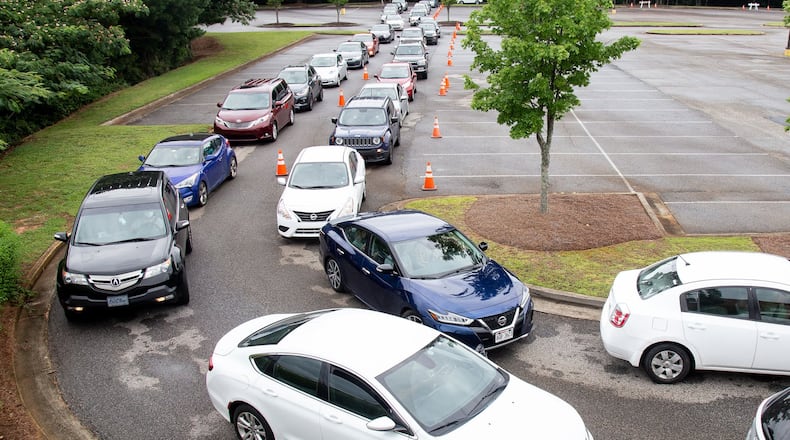Georgia on Tuesday surpassed 100,000 cases of COVID-19, an insidious disease that's hit every corner of the state, and disproportionately impacted communities of color as measured by hospitalizations and deaths.
But an Atlanta Journal-Constitution analysis of COVID-19 data through the end of June shows the state Department of Public Health (DPH) only knows race and ethnicity in fewer than seven out of 10 confirmed cases.
In June, as cases of the coronavirus surged to new highs, the gap in the state’s knowledge of race and ethnicity data only grew worse. Last month, DPH knew the race and ethnicity of an individual with a confirmed case of COVID-19 just slightly more than half the time.
The gaps in case data risk hampering the public health response to COVID-19 particularly in the most vulnerable communities, health experts say.
“Public health is about putting in place what we need to ensure the health of a population,” said Dr. Harry J. Heiman, a clinical associate professor at the Georgia State University School of Public Health. “That means identifying which groups are at increased risk and why and putting policies and practices in place to protect those populations.”
Coronavirus in Georgia: COVID-19 Dashboard
The data are more complete for hospitalizations and deaths, but both those measures can lag new infections by weeks.
The break down in data collection often stems from laboratories that process coronavirus tests. DPH spokeswoman Nancy Nydam said most COVID-19 cases are reported electronically via labs, most of which do not report patients’ race and ethnicity. The largest providers are LabCorp and Quest.
DPH collects race and ethnicity data at its test sites, but not all testing centers do.
Though the state is working with major labs to improve electronic reporting, Nydam said most race and ethnicity data is collected by the state through follow-up interviews with people who test positive.
But that’s labor intensive, and interviews aren’t always successful or possible.
“The missing data are a concern; however, it is important to remember that in epidemiologic surveillance, we look at ‘big picture,’” Nydam said in an email. “While data may be missing on individual cases, we are still able to see what is happening in populations, especially when the pattern follows what we know to be true globally. Our outreach to populations that are disproportionately affected by COVID-19 is not dependent on individual cases — we are working daily to educate and encourage communities to take action to prevent the spread of COVID-19, and how to care for those who do become sick.”
Hospitalizations, deaths show disparities
The poor, minorities and elderly are more likely to have pre-existing conditions that worsen COVID-19.
Compared to cases, Georgia knows the race and ethnicity of about nine out of 10 people hospitalized for COVID-19 and in nearly all deaths. Hospitalization and death data provide stark pictures of the racial and ethnic disparities of COVID-19.
Black people make up about a third of Georgia residents, but account for about half of hospitalizations and deaths through June 30. Hispanics and Latinos, who make up 10% of Georgians, account for more than 17% of all hospitalizations for COVID-19 and 5% deaths. But the death figure is growing.
A New York Times analysis of national data from the Centers for Disease Control and Prevention found Latinos and African Americans in the U.S., so far, have been three times more likely than whites to become infected with the virus and about twice as likely to die. The Times analyzed detailed data from 640,000 infections from about 1,000 U.S. counties in a CDC data set the newspaper had to sue the federal government to obtain.
The state case data obtained by the AJC show characteristics of the pandemic changing over time, though picture isn’t complete. The percentages of cases among whites and Hispanics are growing.
Age data, which is far more complete for cases than racial and ethnicity data, have shown that adults under 30 are the fastest growing demographic for new cases.
Whites made up about 40% of hospitalizations in June, up from about 31% in March. African Americans made up about 64% of hospitalizations in March and 41% in June.
But the fastest growth in hospitalizations is among Hispanics, who accounted for 6.5% of them in March but about 28% of them in June.
Other reporting gaps
Cases have climbed as social distancing has broken down across the state.
Minority and low-income communities face many barriers to health care, said Shivani A. Patel, assistant professor of global health at Emory University’s Rollins School of Public Health. The same historically marginalized communities are taking the brunt of the virus.
“That’s why we are extremely interested in what happens in minority communities,” Patel said. “We can’t measure what we don’t know, and we don’t know the race and ethnic composition of about 50% of the (newest) cases.”
Patel said DPH shares that concern and has created a health equity working group to try to address inequities regarding COVID-19.
But there are other reporting gaps.
Little is known about cases and socioeconomic conditions of infected individuals. Emory has launched a health equity dashboard to try to chart how the coronavirus is affecting different communities based on factors like health outcomes, demographics and income.
Minorities also are over-represented in-service work, agriculture and meat processing — work settings that make people more likely to contract the virus because of the inability to socially distance. Poorer individuals may not have paid sick leave or the means to stay home from work and also may have more difficulty isolating themselves from others.
The state has seen a rise in cases among Hispanic farm and poultry workers. Many Hispanic families live in multi-generational settings where the virus can spread.
Private labs a problem
Dr. Melanie Thompson, principal investigator of the AIDS Research Consortium of Atlanta and a practicing physician, said data gaps in race and ethnicity are systemic.
Thompson said she reviewed test requisition forms for LabCorp and Quest and found there was no place to record race and ethnicity. Early on, the state’s public health lab also didn’t collect race and ethnicity, though that changed after public outcry.
“It’s a real dilemma for public health because they don’t control the private labs,” Thompson said.
But Thompson said other states that also rely heavily on private labs to process tests have more complete racial data, and Georgia needs to learn from them. Following up in interviews isn’t the best strategy, she said.
Some people won’t participate with post-infection investigations or contact tracing. The issue of ethnicity is a sensitive one for some, particularly people who might be at risk for deportation.
“You cannot make up for data not collected at the time of the sample,” Thompson said.
Another flaw is that Georgia doesn’t report the demographic information of all tests, only positive ones. That leaves researchers without valuable data about positivity rates among different groups.
That information would help DPH direct testing where it is needed most, Thompson said.
“It’s not impossible,” she said of getting the data. “It’s not an easy lift, but it’s not impossible.”
Data specialist John Perry contributed to this report.
About the Author
Keep Reading
The Latest
Featured




